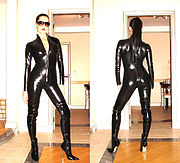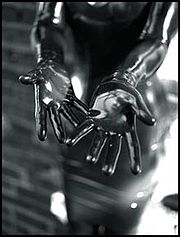
Latex clothing
Encyclopedia

Latex rubber
Rubber
Natural rubber, also called India rubber or caoutchouc, is an elastomer that was originally derived from latex, a milky colloid produced by some plants. The plants would be ‘tapped’, that is, an incision made into the bark of the tree and the sticky, milk colored latex sap collected and refined...
is used in many types of clothing. Rubber has traditionally been used in protective clothing, including gas mask
Gas mask
A gas mask is a mask put on over the face to protect the wearer from inhaling airborne pollutants and toxic gases. The mask forms a sealed cover over the nose and mouth, but may also cover the eyes and other vulnerable soft tissues of the face. Some gas masks are also respirators, though the word...
s and Wellington boot
Wellington boot
The Wellington boot, also known as rubber-boots, wellies, wellingtons, topboots, billy-boots, gumboots, gummies, barnboots, wellieboots, muckboots, sheepboots, shitkickers, or rainboots are a type of boot based upon leather Hessian boots...
s. Rubber is now generally being replaced in these application by plastics. Mackintosh
Mackintosh
The Mackintosh or Macintosh is a form of waterproof raincoat, first sold in 1824, made out of rubberised fabric...
es have traditionally been made from rubberized cloth.
Latex
Latex
Latex is the stable dispersion of polymer microparticles in an aqueous medium. Latexes may be natural or synthetic.Latex as found in nature is a milky fluid found in 10% of all flowering plants . It is a complex emulsion consisting of proteins, alkaloids, starches, sugars, oils, tannins, resins,...
rubber as a clothing
Clothing
Clothing refers to any covering for the human body that is worn. The wearing of clothing is exclusively a human characteristic and is a feature of nearly all human societies...
material is common in fetish fashion
Fetish fashion
Fetish fashion is any style or appearance in the form of atype of clothing or accessory, created to be extreme or provocative. These styles are not usually worn by the majority of people on any regular basis. They are usually made of materials such as leather, latex or synthetic rubber or plastic,...
and among BDSM
BDSM
BDSM is an erotic preference and a form of sexual expression involving the consensual use of restraint, intense sensory stimulation, and fantasy power role-play. The compound acronym BDSM is derived from the terms bondage and discipline , dominance and submission , and sadism and masochism...
practitioners, and is often seen worn at fetish club
Fetish club
A fetish club is a nightclub, bar or other entertainment hub which caters to clientele interested in some of fetish fashion, bondage, dominance/submission, and/or sadism and masochism...
s. Latex is sometimes also used by couturier
Couturier
A couturier is an establishment or person involved in the clothing fashion industry who makes original garments to order for private clients. A couturier may make what is known as haute couture. Such a person usually hires patternmakers and machinists for garment production, and is either employed...
s for its dramatic appearance. Worn on the body it tends to be skin-tight, producing a "second skin" effect. There are several magazines dedicated to the use and wearing of it. Less commonly, latex clothing can be loose-fitting.
Design and manufacture
There are a handful of companies around the world which manufacture latex rated as suitable for contact with human skin. These firms supply sheet (in the vast majority) to a larger number of smaller fashion clothing companies. In the past, some marketplaces suffered from de facto monopoly supply conditions, where a sheet supplier could impose restrictive ordering requirements. Only being able to order half-kilometre long batches of sheet in the colour and thickness they wanted, meant that designers and clothing producers often had to co-operate, or face long delays in supplying their customers, if they wanted to be in the rubber clothing business.Since 2000, however, the sheet market has been exposed to competition from international suppliers courtesy of the Internet. This has produced an explosion in cottage industry scale latex fetish clothing manufacturers.
Latex sheet based clothing is constructed by a three-stage process. First a pattern for a specific garment is selected, and adjusted carefully to suit the measurements supplied by the customer. Then the sheet latex is cut out on a flat board, by hand: lastly latex glue is used to join seams together. Skilled latex makers can build a stocking, shaped to match the contours of a specific person's leg, made from latex only 0.2mm thick, in under an hour. It is possible to use water-based glues such as Copydex to make latex clothes; however, the long-term durability of items made this way is somewhat dubious
Latex moulded clothing is produced by dipping a mould into a vat of liquid rubber. This is a more dangerous process than sheet latex construction because the substances that make latex into a liquid and then evaporate off the dipped mould, are toxic. The resulting clothing suffers from some shortcomings when compared with sheet-based items: mostly this is because controlling the thickness of the layer resulting from dipping is very hard, and a variation in thickness equates to a variation in stretchiness. Most moulded items suffer rapid failure for this reason - pull too hard on a thin rubber sheet and it will rip, and the varying thickness of a moulded item makes it hard to guess when too much stress is being applied.
Generally, cheaper rubber garments are made on moulds that are dipped in a vat of liquid latex, and more expensive items are cut and glued together from flat sheet latex. Sheet is much stronger and more durable than moulding and carries a higher shine.
Neither moulded, nor sheet-based, latex is amenable to large scale mass production. Skilled manual artistry is an integral part of the process; this means that made-to-measure and special designs are much more accessible to the general buyer, in looking at fetish latex, than is the case with regular textiles.
Latex clothing

Leotard
A leotard is a skin-tight one-piece garment that covers the torso but leaves the legs free. It was made famous by the French acrobatic performer Jules Léotard ....
s, bodysuit
Bodysuit
In clothing, a bodysuit, body-liner, or body is a unisex form-fitting garment that covers the torso. The bodysuit often has sleeves and varying collars. A bodysuit is distinguished from the similar leotard by the use of snaps or hooks at the crotch. A bodysuit may be worn as a top for the smooth...
s, stocking
Stocking
A stocking, , is a close-fitting, variously elastic garment covering the foot and lower part of the leg. Stockings vary in color, design and transparency...
s and glove
Glove
A glove is a garment covering the hand. Gloves have separate sheaths or openings for each finger and the thumb; if there is an opening but no covering sheath for each finger they are called "fingerless gloves". Fingerless gloves with one large opening rather than individual openings for each...
s, besides other garments. Latex is also often used to make specialist fetishistic garments like hoods and rubber cloaks.
Latex clothing is generally made from large sheets of latex which are delivered in rolls. The "classic" colour for fetishistic latex clothing is black, but latex is naturally translucent, and may be dyed any colour, including metallic shades or white. It can come in thicknesses which generally range from about 0.18 mm to 0.5 mm. Instead of being sewn, latex clothing is generally glued along its seams.
Because latex sheet is relatively weak, latex clothing needs special care to avoid tearing. Whilst latex can be repaired using materials similar to those provided in a bicycle repair kit, the result is rarely as attractive as the original appearance of the garment.
Latex clothing is often polished to preserve and improve its shiny appearance.
Putting on latex clothing can be difficult, because latex has high friction against dry skin. To make it easier to put on, wearers often use talc
Talc
Talc is a mineral composed of hydrated magnesium silicate with the chemical formula H2Mg34 or Mg3Si4O102. In loose form, it is the widely-used substance known as talcum powder. It occurs as foliated to fibrous masses, its crystals being so rare as to be almost unknown...
to reduce friction against the skin when putting the clothes on; then, because stray talc is very visible against the rubber, wearers generally polish off any visible talc. Another method of dressing is using lubricant (or 'lube') which provides a slippy surface for the latex to glide over. A third method of reducing or eliminating the high friction of latex when dressing is to chlorinate the rubber. Chlorine in gaseous form is generated by the reaction of hydrochloric acid and sodium hypochlorite. This chlorine bonds to the first few molecules on the surface of the isoprene
Isoprene
Isoprene , or 2-methyl-1,3-butadiene, is a common organic compound with the formula CH2=CCH=CH2. Under standard conditions it is a colorless liquid...
(latex) and transforms them into neoprene
Neoprene
Neoprene or polychloroprene is a family of synthetic rubbers that are produced by polymerization of chloroprene. Neoprene in general has good chemical stability, and maintains flexibility over a wide temperature range...
. This process affects metallic colours, but does not affect strength.
Latex may also be painted directly onto the body as latex in liquid form, which is also sometimes used to close seams in the creation of latex clothing. Removal of a painted on liquid latex garment can result in painful hair removal. Wearers avoid this by preparing the skin by prior hair removal, the use of release agents to prevent the latex adhering to the hair, or using products such as orange oil
Orange oil
Orange oil is an essential oil produced by cells inside the rind of an orange fruit. In contrast to most essential oils, it is extracted as a by-product of orange juice production by centrifugation, producing a cold-pressed oil...
to weaken the latex during removal.
In media
It is suggested in various media that the "second skin" effect of latex can aid someone in being stealthy. It lacks the noises common to loose clothing and is less restrictive of movement. For example, one of the "angels" in Charlie's Angels: Full ThrottleCharlie's Angels: Full Throttle
Charlie's Angels: Full Throttle is a 2003 American action comedy film. It is the sequel to 2000's Charlie's Angels. It opened in the United States on June 27, 2003, and was number one at the box office for that weekend and made a worldwide total of $259.2 million.The cast again includes Cameron...
is shown at the start of the film infiltrating a building by cutting the window glass while wearing a skintight catsuit of metallic silver-coloured latex.

